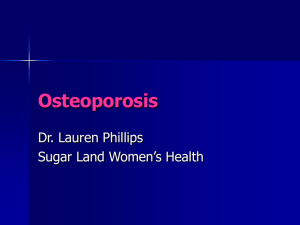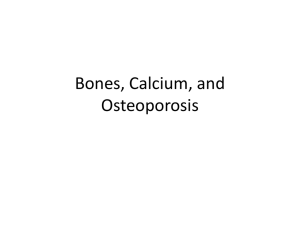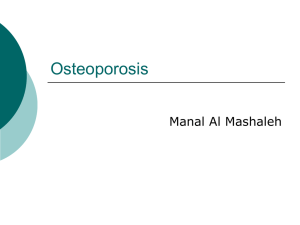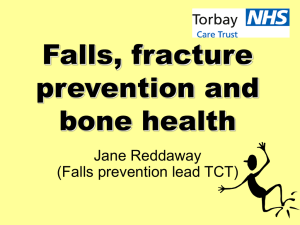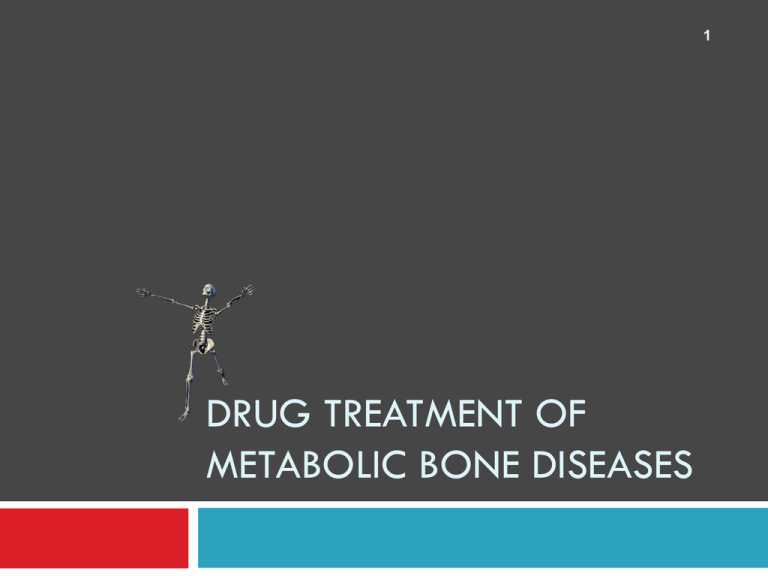
1
DRUG TREATMENT OF
METABOLIC BONE DISEASES
Bone remodeling
2
Bone is in a dynamic state of loss (resorption)
followed by formation. These two opposing
processes are called bone remodeling and are
usually coupled in bone-remodeling units (BRUs).
Bone Remodeling Cycle in Normal Bone
Osteoclasts
digest bone within a
sealed resorption vacuole
Resorption
Bone
Reversal
Resting
Bone
Apoptotic
osteoclasts
Bone
Preosteoblasts
Mature osteoblasts
building osteoid
tissue
Mineralization
3
Bone
Formation
Bone remodeling
4
Steps of bone remodeling:
1- Stimulation of osteoclasts. Osteoclasts secrete collagenases
and proteinases that solubilize bone matrix, releasing
calcium into circulation for physiological functions.
2- Once osteoclasts die, osteoblasts differentiate and lay
down new bone matrix (osteoid) at the sites of previous
resorption.
3- Once bone formation is complete, osteoblasts are
inactivated and differentiate into osteocytes on the surface
of the new bone.
4- The new bone is then mineralized with hydroxyapatite. The
complete mineralization and hardening process takes
several months.
Metabolic bone diseases
5
1- Osteoporosis: A skeletal disorder characterized by
compromized bone strength with an increased risk
of fracture.
2- Osteomalacia and rickets: abnormal bone
formation due to inadequate mineralization
3- Paget’s disease: Localized bone disease
characterized by uncontrolled bone resorption with
secondary increase of bone formation. The new
bone is poorly organized.
Osteoporosis
6
Mechanism of osteoporosis:
Imbalance between rate of resorption and formation
Normal bone
No
Osteoporosis
Osteoporosis
7
Types of osteoporosis
Primary
Type 1- post menopausal
Type 2- senile
Secondary
Medications
Steroid induced
Medical conditions
Osteoporosis - types
8
I- Postmenopausal osteoporosis (type I)
Mechanism:
˗ Estrogen deficiency causes:
1. increases proliferation and activation of osteoclasts
2. prolongs survival of osteoclasts
II- Senile osteoporosis (type II)
Bone loss due to increased bone turnover
Malabsorption
Mineral and vitamin deficiency
Secondary osteoporosis
9
Drugs causing osteoporosis
10
1- Long-term glucocorticoids
2- Anticoagulants
3- Gonadotropin-releasing hormone agonists
4- Antiepileptic drugs
5- Furosemide
Drugs causing osteoporosis
11
Drug-induced osteoporosis:
1- Long-term glucocorticoids
Proposed mechanisms of osteoporosis:
a)
alteration in calcium absorption and elimination leading to
secondary hyperparathyroidism
b)
inhibitory effect on sex hormone production
c)
direct inhibition of osteoblast function.
Inhaled corticosteroids do not decrease bone density at low to
moderate dosages, but may have some effect at higher dosages.
Some bone mass restoration may occur on withdrawal of
glucocorticoid therapy.
Drugs causing osteoporosis
12
•
1.
2.
3.
Prevention of glucocorticoid-induced osteoporosis in
patients who will take glucocorticoids for > 6 months
Consider thiazide diuretic if otherwise indicated (e.g.,
patient is hypertensive)
Correct hypogonadal state if present
A) Premenopausal women: oral contraception
B) Postmenopausal women: estrogen ± progesterone
C) Men: testosterone
Consider alternative or additional therapy
A) Bisphosphonates (alendronate, risedronate,
etidronate)
B) Calcitonin for patients who cannot take bisphosphonates
Drugs causing osteoporosis
13
2- Anticoagulants:
1. Long-term use of high dose heparin therapy (>15,000 U/day for
>3 months) can cause reversible osteoporosis.
Potential mechanisms include:
A) increased osteoclast activity
B) decreased osteoblast activity
D) heparin-induced increase in collagenase activity
E) decrease in the production of 1,25-hydroxyvitamin D [1,25(OH)2-D] caused by decreased renal conversion enzyme
activity.
2. Long-term oral anticoagulants may increase the risk of osteoporosis
by their antagonistic effect on vitamin K, a key factor in the synthesis
of bone matrix proteins.
Drugs causing osteoporosis
14
3- Gonadotropin-releasing hormone agonists
The gonadotropin-releasing hormone (GnRH) agonists,
leuprolide, goserelin, and nafarelin.
Prevention:
use of these agents must be limited to 6 months
If more than 6 months are required, a bone-protective
agent is used concurrently as low-dose estrogen
and progesterone or progesterone alone or
bisphosphonates.
Drugs causing osteoporosis
15
4- Antiepileptic drugs (e.g. phenytoin)
Mechanism: induction of cytochrome P450 which
converts vitamin D into inactive metabolites.
5- Other substances
• Furosemide and other loop diuretics decrease serum
calcium.
Osteoporosis
16
Prevention and treatment of primary osteoporosis
A. Non-pharmacological
1)
2)
3)
4)
5)
Life style modification: Stop alcohol and smoking and increase
Ca in diet.
Regular exercise
Avoid drugs that induce osteoporosis
B. Pharmacological therapy:
Bisphosphonates
Calcium
Vitamin D
Estrogen
Estrogen receptor modulators (SERM)
Osteoporosis
17
Treatment of osteoporosis
I- Antiresorptive therapy:
1)
Bisphosphonates (first line)
2)
Calcium
3)
Vitamin D
4)
Estrogen
5)
Estrogen receptor modulators
(SERM)
6)
Calcitonin
II- Anabolic therapy:
1) Teriparatide
Mechanism of action of
bisphosphonates
18
1.
BISPHOSPHONATES bind to bone mineral surface
2.
BISPHOSPHONATES are taken up by the osteoclast
3.
BISPHOSPHONATES induce apoptosis of osteoclasts
19
Available Bisphosphonates for
Osteoporosis
20
Oral
Alendronate (daily, weekly)
Risedronate (daily, weekly, monthly)
Ibandronate (daily, monthly)
Intravenous
Ibandronate (quarterly)
Zoledronic acid (annual)
Bisphosphonates
21
Absorption, Fate, and Excretion.
very poorly absorbed from the intestine and have bioavailability <1% to
6%].
Bisphosphonates are excreted primarily by the kidneys. Bisphosphonates
are not recommended for patients with impaired renal function
Adverse Effects
Alendronate may cause esophagitis, gastritis or peptic ulcer
Mild fever and aches may attend the first parenteral infusion of
pamidronate, likely owing to cytokine release. These symptoms are shortlived and generally do not recur with subsequent administration.
Zoledronate has been associated with renal toxicity, deterioration of renal
function, and potential renal failure.
Bisphosphonates
22
Alendronate and Risedronate
Indications:
1.
Prevention of osteoporosis in postmenopausal
women
2.
Treatment of osteoporosis in men, postmenopausal
women, and those with corticosteroid-induced
osteoporosis.
3.
Treatment of hypercalcemia associated with
malignancy
23
24
Inability to sit down or stand
Calcium
25
Action:
Calcium alone is inadequate to completely inhibit the rapid bone loss
that occurs at menopause but is necessary to optimize response to
antiresorptive agents.
Administration:
Orally as calcium carbonate, phosphate, citrate, …
Adverse effects:
Mainly GIT as:
1. Nausea
2. Constipation (treated by increased water intake, dietary fibers
and excercise)
3. Abdominal distension (with calcium carbonate. Treated by using
calcium citrate instead)
Calcium
26
Drug interactions:
1.
Fibers and iron therapy impair absorption
2.
Patients should take tetracycline compounds and calcium at
least 2 hours apart to avoid intestinal chelation.
Dose for elderly men and women:
• A total daily calcium intake of 1500 mg is recommended for
elderly men and women = about 1000 mg/day as a drug +
400 to 500 mg of dietary calcium found in the diet of elderly
men and women
Vitamin D
27
Specific Forms of Vitamin D.
Calcitriol (1,25-dihydroxycholecalciferol) is available for oral
administration or injection.
1a-hydroxyvitaminD3 is a synthetic vitamin D3 derivative. It is
rapidly hydroxylated in the liver to form 1,25-(OH)2D3. It is
used to treat renal rickets
1a-hydroxyvitamin D2: activated by hepatic 25-hydroxylation
to generate the biologically active compound, 1a,25-(OH)2D2
Vitamin D2: It is available for oral, intramuscular, or intravenous
administration.
Vitamin D
28
Action:
1,25-(OH)2-D enhances GI absorption of calcium.
Forms of vitamin D for use in osteoporosis:
1)
Vitamin D2 and D3 (dose for either=800 IU/
2)
1,25-(OH)2-D (calcitriol, dose=0.5 μg/d).
Distribution:
1)Distributed bound to vitamin D-binding protein (αglobulin)
2) Vitamin D is hydroxylated in the liver and kidney to
produce the physiologically active compound 1,25(OH)2-D (calcitriol).
Vitamin D
29
Indications:
Patients at risk for vitamin D deficiency, such as older
adults or patients on low-dose corticosteroids or
anticonvulsant therapy.
Adverse effects:
Hypercalcemia (symptoms: anorexia, nausea and
weakness)
Drug interactions:
Concomitant use of thiazide diuretics and calcitriol may
increase the risk of hypercalcemia.
Estrogen
30
Mechanism of action in osteoporosis:
Estrogen suppresses bone resorption by inhibiting osteoclasts
Adverse effects:
1.
increase the incidence of breast and endometrial cancers
2.
increase in risks for deep venous thrombosis and gall bladder
disease.
Prescription:
Long-term use of estrogen (>5y) carries the risk of breast and
endometrial cancer. Therefore, estrogen is not prescribed for
prevention or treatment of osteoporosis.
Women who are using estrogen for management of menopausal
symptoms will experience a delay in postmenopausal bone loss and
may be able to postpone initiation of antiosteoporotic therapy until
they discontinue HT
31
↓Total cholesterol
↓LDL
No effect on HDL, TG
Selective estrogen receptor
modulators (SERMs)
32
Uses:
1.
Postmenopausal women at risk for osteoporosis
who cannot take bisphosphonates
2.
Postmenopausal women at increased risk for
breast cancer
33
Calcitonin
(Salmon calcitonin)
34
Mechanism of action:
1)
Inhibits bone resorption by inhibiting osteoclast activity
(with time both formation and resorption are reduced)
2)
Has an analgesic effect on acute pain from VF that is
independent of its effects on bone metabolism.
Administration:
Given by injection (subcutaneous or intramuscular) and
intranasaly. Patients should ingest adequate calcium and
vitamin D during calcitonin treatment (why?).
35
Calcitonin
(Salmon calcitonin)
Side effects of injectable calcitonin (minimized by
S.c., not i.m., injection.
1)
Nausea and GI discomfort
2)
Initial facial flushing and dermatitis
3)
Pruritus at the injection site.
Side effects of nasal calcitonin :
1)
Rhinitis
Indications:
1)
2nd line treatment for patients with osteoporosis
who cannot tolerate other antiosteoporotic agents.
36
Teriparatide
(recombinant PTH)
37
Indications:
Treatment of osteoporosis in men and postmenopausal
women who have failed antiresorptive therapy.
Administration:
Injected daily s.c.
Use of this agent is limited to 2-years duration due to
lack of long-term safety data.
38
Osteomalacia
39
Causes of osteomalacia:
1.
Most common cause: severe, prolonged vitamin D
deficiency.
2.
Drugs that can cause osteomalacia:
Longterm anticonvulsant therapy (mechanism:
phenytoin, phenobarbital, and carbamazepine induce
cytochrome P450 system →↑vitamin D conversion to
inactive metabolites). Prevention: oral vitamin D3 from
1,000 to 4,000 units per day.
Osteomalacia
40
Pathophysiology
In osteomalacia: normal bone resorption and
formation
Osteomalacia is characterized by the body's inability
to fully mineralize the newly formed osteoid tissue,
resulting in decreased bone strength
Treatment of osteomalacia:
High-doses of vitamin D
Rickets
41
Nutritional
Deficiency of
vitamin D
Vitamin D
X linked
resistant rickets
1. Diet
2. Vitamin D
Large doses of vitamin
D
Vitamin D
dependent
rickets type I
Autosomal
recessive
Mutations in 1aPhysiological doses of
hydroxylase leading vitamin D3
to decreased
formation of
1,25(OH)₂-vitamin D
Vitamin D
dependent
rickets type II
Autosomal
recessive
Mutations of the
Refractory to vitamin D
vitamin D receptor
– treated with i.v. Ca
with increased
formation of
1,25(OH)₂-vitamin D
Renal
Renal failure
osteodystrophy
decreased
1a-hydroxyvitaminD3
formation of
(alfacalcidol) or
1,25(OH)₂-vitamin D calcitriol
Paget’s disease
42
Paget’s disease is a disorder of bone remodeling in discrete sections of bone.
The main areas affected are the skull, spine, pelvis, femur, and tibia.
Pathogenesis:
It is characterized by increased bone resorption and formation. The
accelerated bone formation does not allow for proper layering of collagen
leading to disorganized or woven collagen.
Treatment:
1. Bisphosphonates are the drug of choice for managing Paget’s disease
because they work directly on osteoclasts to slow down bone turnover,
allowing more time for proper bone formation. Therapy can be repeated if
symptoms return or serum alkaline phosphatase increases by 25% or more.
2. Subcutaneous or intramuscular salmon calcitonin can be used if
bisphosphonates therapy is contraindicated.
43



